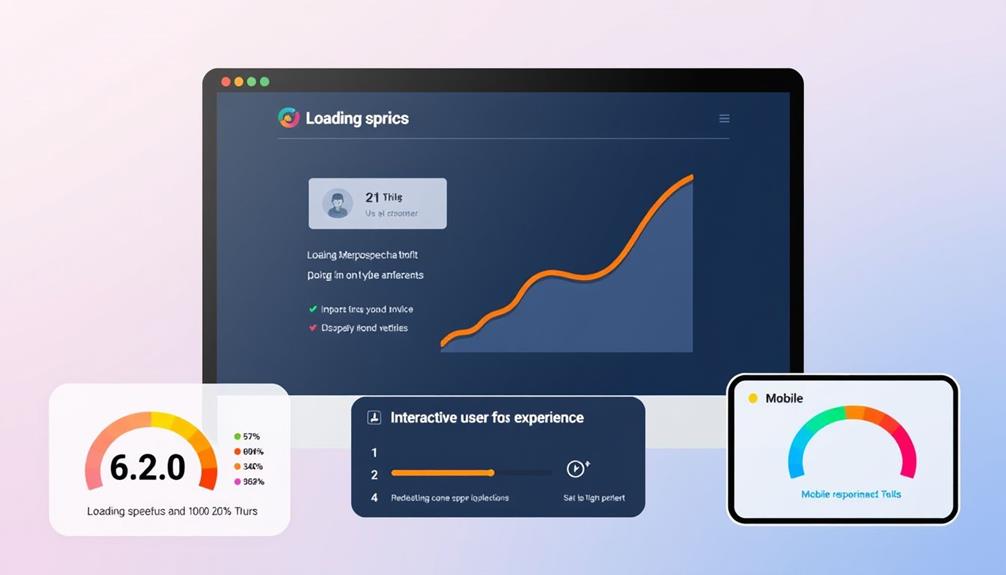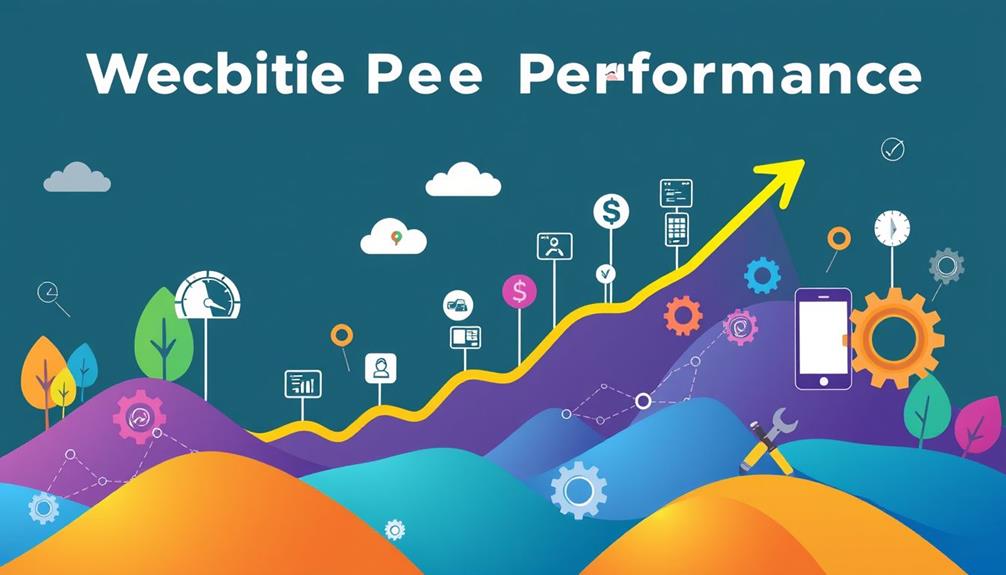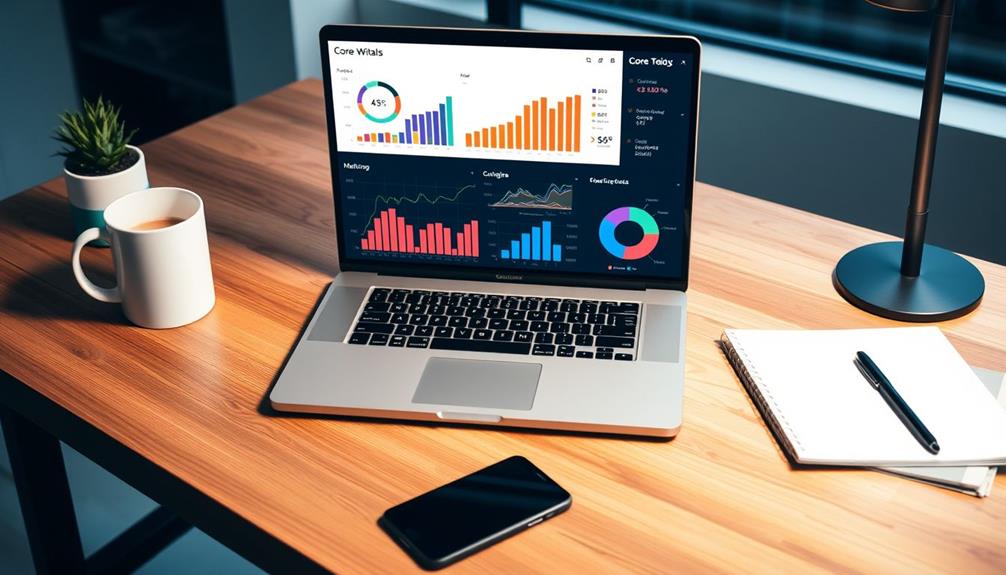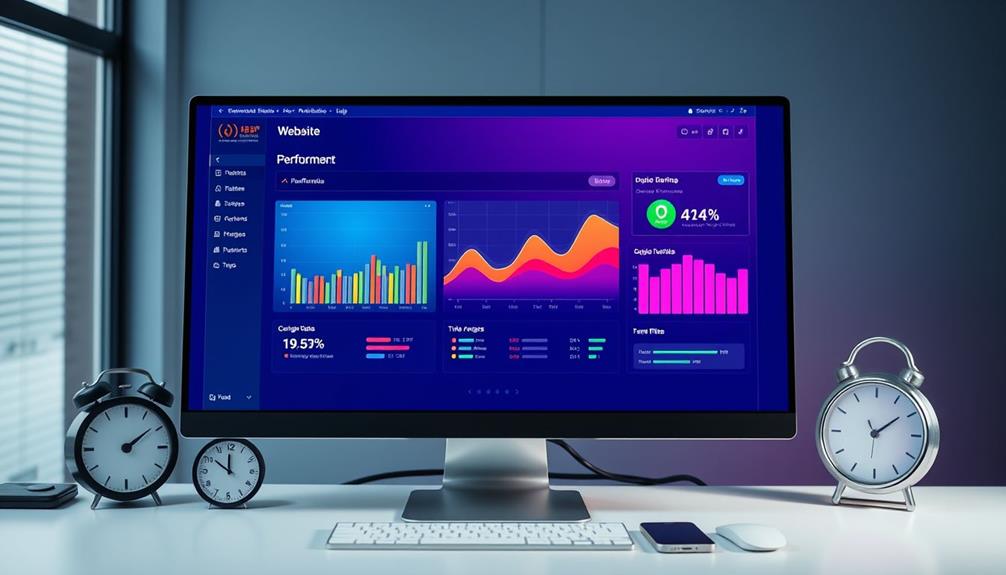To optimize for Google's Page Experience Update, focus on Core Web Essentials: LCP, FID, and CLS. Aim for an LCP under 2.5 seconds by optimizing images and using a CDN. Keep your FID below 100 milliseconds by reducing heavy JavaScript execution. For a stable CLS score under 0.1, reserve ad space and specify image dimensions. Regularly monitor your site's performance with tools like Google PageSpeed Insights and Lighthouse. Staying on top of these metrics not only boosts user satisfaction but can also improve your search rankings. There's so much more to explore to enhance your site's performance effectively.
Key Takeaways
- Focus on optimizing LCP by compressing images and utilizing a CDN to achieve loading times under 2.5 seconds.
- Reduce JavaScript execution to maintain FID below 100 milliseconds for better interactivity and user engagement.
- Ensure visual stability by specifying image dimensions and reserving ad space to keep CLS under 0.1.
- Regularly monitor Core Web Vitals using tools like Google PageSpeed Insights and Lighthouse for actionable performance insights.
- Stay updated on algorithm changes and prioritize user experience to maintain search rankings and avoid traffic declines.
Understanding Core Web Vitals
Understanding Core Web Vitals is crucial for anyone looking to improve their website's performance and user experience. These user experience metrics consist of three key components: Largest Contentful Paint (LCP), First Input Delay (FID), and Cumulative Layout Shift (CLS).
LCP measures the loading performance, with a perfect time of under 2.5 seconds. If your largest visible content element takes longer to load, it can negatively affect your Core Web Vitals scores and ultimately your SEO rankings. Implementing effective keyword clustering strategies can also contribute to better loading times and improved user experience.
Next, FID assesses interactivity, focusing on the delay between a user's first interaction and the browser's response. An ideal response time is less than 100 milliseconds. Heavy JavaScript execution can hinder this, leading to increased bounce rates and frustrated visitors.
Importance of Page Experience

Page experience plays a significant role in determining your website's success, as it combines fundamental user interaction signals with traditional SEO elements.
Google's ranking system now prioritizes page experience, making it imperative for you to focus on optimizing these factors. By improving your Core Web Vitals—loading speed, interactivity, and visual stability—you can enhance user satisfaction and increase your website's visibility.
Additionally, just as diversifying investments can bolster financial resilience, guaranteeing a robust page experience can protect your site's performance amidst fluctuating trends in user behavior. Investing in Gold IRAs can similarly provide stability in uncertain times.
Consider these key benefits of a strong page experience:
- Higher Conversion Rates: Smooth loading and interactions encourage users to take action.
- Lower Bounce Rates: Engaging experiences keep visitors on your site longer.
- Improved Mobile Usability: Mobile-friendliness is essential for reaching users on various devices.
- Enhanced Security: Implementing HTTPS boosts trust and improves SEO.
- Competitive Edge: Staying ahead in page experience metrics keeps you relevant in search results.
Neglecting page experience can lead to significant drops in organic traffic, so continuous monitoring and improvement are necessary.
Key Metrics for Optimization

Enhancing your website's performance hinges on three key metrics that define Core Web Essentials: Largest Contentful Paint (LCP), First Input Delay (FID), and Cumulative Layout Shift (CLS).
To achieve ideal loading performance, aim for an LCP of under 2.5 seconds. This metric measures how long it takes for the largest visible content element to load. You can improve LCP by leveraging a Content Delivery Network (CDN) and optimizing your images. Additionally, guaranteeing robust security through AI security provides robust defenses can enhance user trust, which is critical for retaining visitors on your site.
Next, focus on FID, which measures the delay between a user's first interaction with your page and the browser's response. Aim for an FID of less than 100 milliseconds. You can enhance this by minimizing JavaScript execution time and reducing the impact of third-party code.
Lastly, CLS quantifies visual stability by measuring unexpected layout shifts during loading. To guarantee a CLS score of less than 0.1, specify dimensions for images and reserve space for ads to prevent content from shifting unexpectedly.
Regularly monitor these metrics using tools like Google PageSpeed Insights and Google Search Console to maintain ideal performance and stay ahead of changing user experience expectations.
Impact of Algorithm Changes

As you track the impact of algorithm changes, you'll notice a clear timeline highlighting when Google first emphasized Core Web Essentials.
These updates have led to significant ranking changes, particularly for sites that prioritize user experience.
Understanding the importance of social media platforms can also play a role in enhancing user engagement and visibility.
Staying on top of these shifts is crucial if you want to maintain or boost your visibility in search results.
Algorithm Update Timeline
The landscape of search engine rankings is constantly evolving, and understanding the timeline of algorithm updates is crucial for website owners. The Page Experience Update, which began rolling out in June 2021, highlighted the significance of Core Web Vitals in influencing site rankings.
With a six-month notice from Google, you'd ample time to prepare for changes in ranking factors focusing on user experience. Furthermore, the increasing prevalence of remote interactions and collaboration in tech, as seen in hackathon trends, emphasizes the need for effective online presence.
Here are some key points about the algorithm update:
- The update integrates Core Web Vitals with existing ranking signals.
- It emphasizes mobile-friendliness and HTTPS as essential factors.
- The total includes seven signals that affect search visibility.
- Sites prioritizing user experience adapted better to the new metrics.
- Failure to optimize for user experience can lead to significant ranking drops.
This algorithm update is a game-changer for search engine results pages (SERPs). If you haven't optimized for the Core Web Vitals and overall page experience, now's the time to act.
Staying informed and proactive will help you maintain your rankings and improve your site's visibility in an increasingly competitive landscape.
Ranking Changes Observed
Since the rollout of Google's Page Experience Update in June 2021, many websites have seen notable shifts in their search rankings. This update placed significant emphasis on Core Web Vitals, which measure important aspects of user experience, including loading performance, interactivity, and visual stability.
If your site didn't optimize for these metrics—particularly Largest Contentful Paint (LCP), First Input Delay (FID), and Cumulative Layout Shift (CLS)—you likely experienced declines in your search rankings. Websites that focused on key factors in choosing a home cleaning service and prioritized user experience adapted better to these changes and benefited from enhanced visibility in search results.
Despite the six-month preparation period, many site owners still faced ranking changes due to inadequate optimization efforts. The update highlighted the ongoing need to monitor and improve your Core Web Vitals regularly. Ignoring these metrics could lead to sudden drops in organic traffic, making it essential to stay proactive in enhancing user experience.
Ultimately, the impact of this algorithm change has been significant, reinforcing that a focus on Core Web Vitals is important for maintaining and improving your site's search ranking in today's competitive landscape.
User Experience Emphasis
Increasingly, websites that prioritize user experience are finding themselves better positioned in search rankings, especially after Google's Page Experience Update.
By incorporating Core Web Vitals into their ranking factors, Google now emphasizes user experience more than ever. If your site doesn't meet the updated standards, you could see a drop in visibility and traffic.
This shift mirrors trends in software quality assurance, where attention to detail guarantees that user interactions are smooth and efficient.
To stay ahead, focus on these key aspects:
- Loading Speed (LCP): Aim for under 2.5 seconds for ideal user experience.
- Interactivity (FID): Keep your first input delay below 100 milliseconds.
- Visual Stability (CLS): Endeavor for a CLS score of less than 0.1.
- Continuous Monitoring: Regularly check your Core Web Vitals scores to catch issues early.
- User Engagement: Enhance site features that keep visitors interacting longer.
Failing to refine for these Core Web Vitals can lead to significant ranking drops.
The update aims to improve user satisfaction, as higher scores directly correlate to better engagement and conversion rates.
Make user experience a top priority, and you'll likely reap the rewards in search rankings.
Strategies for Improvement

To enhance your website's performance, focusing on Core Web Essentials is crucial. By implementing effective strategies for improvement, you can greatly boost your page experience and optimize your site for better user engagement.
Here are some key strategies:
| Core Web Essential | Improvement Strategy | Target Metric |
|---|---|---|
| Largest Contentful Paint (LCP) | Use quality web hosting, CDNs, and optimize images. | Load within 2.5 seconds |
| First Input Delay (FID) | Minimize third-party script impact and reduce JavaScript execution time. | Less than 100 milliseconds |
| Cumulative Layout Shift (CLS) | Provide size attributes for images and reserve ad space. | Score less than 0.1 |
Utilizing performance testing tools like Google PageSpeed Insights and Web.dev helps you identify areas for improvement. Make sure to prioritize fixing URLs that are categorized as Poor according to Google's recommendations. Additionally, continuously monitor your Core Web Essentials metrics through Google Search Console and Lighthouse. This ongoing evaluation will allow you to adapt your site performance strategies and maintain a competitive edge in SEO rankings.
Measuring Core Web Vitals

Measuring Core Web Vitals is essential for understanding your website's performance and user experience. These metrics help you identify areas that need improvement, ensuring your site meets Google's standards.
You can use various tools to measure your Core Web Vitals effectively, including:
- Google PageSpeed Insights: Offers insights on loading performance, interactivity, and visual stability.
- Lighthouse: An open-source tool that audits your web pages and provides performance scores.
- Core Web Vitals report in Google Search Console: Displays performance metrics for all your pages.
In addition, applying email marketing strategies can enhance your site's overall user engagement, which indirectly contributes to better Core Web Vitals.
Key metrics to focus on include:
- Largest Contentful Paint (LCP): Measures loading performance, aiming for under 2.5 seconds.
- First Input Delay (FID): Assesses interactivity, with a target of less than 100 milliseconds.
- Cumulative Layout Shift (CLS): Evaluates visual stability, with a goal of below 0.1.
Continuous monitoring of these Core Web Vitals is important. It enables you to track performance over time, make adjustments, and enhance user experience while maintaining your SEO rankings.
Tools for Performance Tracking

A variety of tools are available to help you track performance effectively and optimize your Core Web Essentials. These tools provide insights into your website's performance, focusing on Core Web Vitals metrics like LCP, FID, and CLS. Here's a breakdown of some top options:
| Tool | Key Features | Best For |
|---|---|---|
| Google PageSpeed Insights | Detailed reports on performance and recommendations | Quick optimization insights |
| Chrome User Experience Report (CrUX) | Real user data on LCP, FID, and CLS metrics | Understanding real user experience |
| GTMetrix | Analyzes page speed with actionable recommendations | Thorough performance analysis |
Lighthouse, a part of Chrome DevTools, lets you run audits on your pages and get suggestions for enhancing Core Web Vitals. If you want to test global performance, WebPageTest simulates real browsers and evaluates your site across various locations. By using these tools for performance tracking, you can identify areas for improvement and guarantee your site meets Google's standards, enhancing user experience and search rankings.
Building a User-Centric Site

Optimizing your website for performance using the right tools sets the stage for building a user-centric site.
To enhance user experience, you need to focus on Core Web Vitals metrics. Aim for the Largest Contentful Paint (LCP) to load in under 2.5 seconds, guarantee a First Input Delay (FID) of less than 100 milliseconds, and maintain a Cumulative Layout Shift (CLS) score below 0.1.
To guarantee a seamless experience, consider the effectiveness of budget-friendly vacuum cleaners when choosing cleaning solutions that align with user satisfaction.
Here's how to achieve that:
- Implement lazy loading for images and videos.
- Use a Content Delivery Network (CDN) for faster page load.
- Minimize render-blocking resources to improve interactivity.
- Reserve space for images and ads to guarantee visual stability.
- Regularly assess performance with Google PageSpeed Insights.
Conclusion
As you immerse yourself in optimizing your site for Core Web Vitals, remember that every second counts. Your users' experience hinges on these metrics, and the stakes are high. Will your site rise in the ranks, or will it fall behind? By implementing the right strategies and tools, you can reveal the key to better performance and happier visitors. Don't wait—start transforming your page experience today, and watch how it impacts your success tomorrow.









